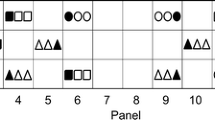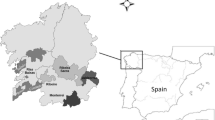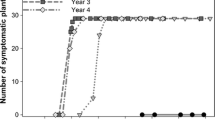Abstract
The spread of grapevine leafroll-associated virus 3 (GLRaV-3) through a newly planted block of Merlot and Chardonnay grapevines in a commercial vineyard was measured between 1998 and 2003. The population changes of the mealybug vector (Pseudococcus longispinus) were recorded over the same period in 12–17-year-old GLRaV-3-infected grapevines immediately adjacent to two sides of the new block. Relationships between the spread of GLRaV-3 and mealybug numbers were examined. Mealybugs developed through three generations a year and populations were low for 4 of the 6 years. Numbers were usually higher in the 12–17-year-old Sauvignon Blanc vines and adjacent young 1–6-year-old Merlot vines than in the 12–17-year-old Breidecker and adjacent young 1–6-year-old Chardonnay vines on the other side of the block. However, GLRaV-3 spread more rapidly in young Chardonnay vines than in young Merlot vines. New infections in both Merlot and Chardonnay initially occurred at random, but newly infected vines were more often clustered from 2002 to 2003, and especially in Merlot. Most newly infected Chardonnay were recorded in the years following the highest numbers of mealybugs, in 1997–98 and 2000–01, but the disease spread more gradually in the Merlot. The data indicated that GLRaV-3 did not spread into the new block when third generation mealybug populations in adjacent infected vines were lower than ∼5 mealybugs/leaf. Three methods for virus transmission by mealybug were proposed: one method was from natural, crawling dispersal of infected mealybugs, leading predominantly to within-row, vine-to-vine transmission; another method was from human-assisted movement of mealybug crawlers (such as on vineyard machinery) leading to random but localised infection on a within- or between-block scale; and a third method was through aerial dispersal of infectious mealybugs, resulting in random infections of vines and particularly operating on a between-block or between-vineyard scale. Infection in any vineyard probably occurs by all three methods, mediated by the poorly understood, and possibly site- and grape variety-specific, transmission ecology that underpins the mealybug-virus-vine relationships.
Similar content being viewed by others
References
Barrass IC, Jerie P, Ward SA (1994) Aerial dispersal of first- and second-instar longtailed mealybug, Pseudococcus longispinus (Targioni Tozzetti) (Pseudococcidae: Hemiptera). Australian Journal of Experimental Agriculture 34, 1205–1208. doi: 10.1071/EA9941205
Belli G, Fortusini A, Casati P, Belli L, Bianco PA, Prati S (1994) Transmission of grapevine leafroll associated closterovirus by the scale insect Pulvinaria vitis L. Rivista di Patologia Vegetale 4, 105–108.
Bovey R, Gartel W, Hewitt WB, Martelli GP, Vuittenez A (1980) ‘Virus and virus-like diseases of grapevine.’ (Payot Publishing Co.: Lausanne)
Cabaleiro C, Segura A (1997a) Some characteristics of the transmission of grape leafroll associated virus 3 by Planococcus citri Risso. European Journal of Plant Pathology 103, 373–378. doi: 10.1023/A:1008619523666
Cabaleiro C, Segura A (1997b) Field transmission of grapevine leafroll associated virus 3 (GLRaV-3) by the mealybug Planococcus citri. Plant Disease 81, 283–287. doi: 10.1094/PDIS.1997.81.3.283
Campbell CL, Madden LV (1990) ‘Introduction to plant disease epidemiology.’ (John Wiley & Sons: New York)
Charles JG (1981) Distribution and life-history of the long-tailed mealybug, Pseudococcus longispinus (Homoptera: Pseudococcidae) in Auckland vineyards. New Zealand Journal of Zoology 8, 285–293.
Charles JG (1993) A survey of mealybugs and their natural enemies in horticultural crops in North Island, New Zealand, with implications for biological control. Biocontrol Science and Technology 3, 405–418. doi: 10.1080/09583159309355295
Charles JG, Jordan DT (1993) Mealybugs associated with grapevine leafroll disease (GLR). In ‘Proceedings of the New Zealand grape and wine symposium, New Zealand Society of Viticulture and Oenology, Auckland, New Zealand’. (Ed. DT Jordan) pp. 31–34. (New Zealand Society for Viticulture and Oenology: Auckland, New Zealand)
Cid M, Pereira S, Cabaleiro C, Faoro F, Segura A (2007) Presence of Grapevine leafroll-associated virus 3 in primary salivary glands of the mealybug vector Planococcus citri suggests a circulative transmission mechanism. European Journal of Plant Pathology 118, 23–30. doi: 10.1007/s10658-006-9090-8
Clark MF, Adams AN (1977) Characteristics of the microplate method of ELISA for the detection of plant viruses. The Journal of General Virology 34, 475–483. doi: 10.1099/0022-1317-34-3-475
Cohen D, van den Brink R (2000) Improved sensitivity for ELISA detection of GLRaV-1 and GLRaV-3. In ‘Extended Abstracts, 13th meeting of the ICVG, Adelaide Australia, 12–17th March 2000, University of Adelaide, Adelaide, Australia.’. (Ed. RH Symons) pp. 146–147. (ICVG: Adelaide)
Dolja VV, Karasev AV, Koonin EV (1994) Molecular biology and evolution of closteroviruses: sophisticated build-up of large RNA genomes. Annual Review of Phytopathology 32, 261–285. doi: 10.1146/annurev.py.32.090194.001401
Douglas N, Krüger K (2008) Transmission efficiency of Grapevine leafroll-associated virus 3 (GLRaV-3) by the mealybugs Planococcus ficus and Pseudococcus longispinus (Hemiptera: Pseudococcidae). European Journal of Plant Pathology 122, 207–212. doi: 10.1007/s10658-008-9269-2
Fortusini A, Scattini G, Cinquanta S, Prati S (1996) Diffusione naturale del virus 1 (GLRV-1), del virus 3 (GLRV-3) dell’accartocciamento fogliare e del virus della maculatura infettiva o ‘fleck’ (GFkV) della vite. Informatore Fitopatologico 46, 39–43.
Franco JC, Suma P, Borges da Silva E, Blumberg D, Mendel Z (2004) Management strategies of mealybug pests of citrus in Mediterranean countries. Phytoparasitica 32, 507–522. doi: 10.1007/BF02980445
Golino DA, Sim ST, Gill R, Rowhani A (2002) California mealybugs can spread grapevine leafroll disease. California Agriculture 56, 196–201.
Gugerli P, Brugger J, Bovey R (1984) L’enroulement de la vigne: mise en évidence de particules virales et développement d’une méthode immunoenzymatique pour le diagnostic rapide. Revue Suisse de Viticulture, d’Arboriculture et d’Horticulture 16, 299–304.
Habili N, Nutter FW Jr (1997) Temporal and spatial analysis of grapevine leafroll-associated virus 3 in Pinot Noir grapevines in Australia. Plant Disease 81, 625–628. doi: 10.1094/PDIS.1997.81.6.625
Jordan D, Petersen C, Morgan L, Segaran A (1993) Spread of grapevine leafroll associated virus inNewZealand vineyards. In ‘Extended abstracts 11th Meeting ICVG, Montreux, Switzerland, 6–9 September 1993.’ (Ed. P Gugerli). pp. 113–114. (ICVG:)
Ling K-S, Zhu H-Y, Gonsalves D (2004) Complete nucleotide sequence and genome organization of Grapevine leafroll-associated virus 3, type member of the genus Ampelovirus. The Journal of General Virology 85, 2099–2102. doi: 10.1099/vir.0.80007-0
Mannini F, Credi R (2000) Appraisal of and enological modification in the performances of grapevine clones after virus eradication. In ‘Extended Abstracts, 13th meeting of the ICVG, Adelaide Australia, 12–17th March 2000, University of Adelaide, Adelaide, Australia.’. (Ed. RH Symons) pp. 151–154. (ICVG: Adelaide)
Millar JG, Daane KM, Mcelfresh JS, Moreira JA, Malakar-Kuenen R, Guillén M, Bentley WJ (2002) Development and optimization of methods for using sex pheromone for monitoring the mealybug Planococcus ficus (Homoptera: Pseudococcidae) in California vineyards. Journal of Economic Entomology 95, 706–714.
Petersen CL (1996) Epidemiology of grapevine leafroll disease within New Zealand vineyards. M.Sc. Thesis, University of Auckland. Petersen CL, Charles JG (1997) Transmission of grapevine leafroll-associated closteroviruses by Pseudococcus longispinus and P. calceolariae. Plant Pathology 46, 509–515. doi: 10.1046/j.1365-3059.1997.d01-44.x
Sforza R, Boudon-Padieu E, Greif C (2003) New mealybug species vectoring grapevine leafroll-associated viruses-1 and -3 (GLRaV-1 and -3). European Journal of Plant Pathology 109, 975–981. doi: 10.1023/B:EJPP.0000003750.34458.71
Author information
Authors and Affiliations
Corresponding author
Rights and permissions
About this article
Cite this article
Charles, J.G., Froud, K.J., van den Brink, R. et al. Mealybugs and the spread of grapevine leafroll-associated virus 3 (GLRaV-3) in a New Zealand vineyard. Australasian Plant Pathology 38, 576–583 (2009). https://doi.org/10.1071/AP09042
Received:
Accepted:
Issue Date:
DOI: https://doi.org/10.1071/AP09042




